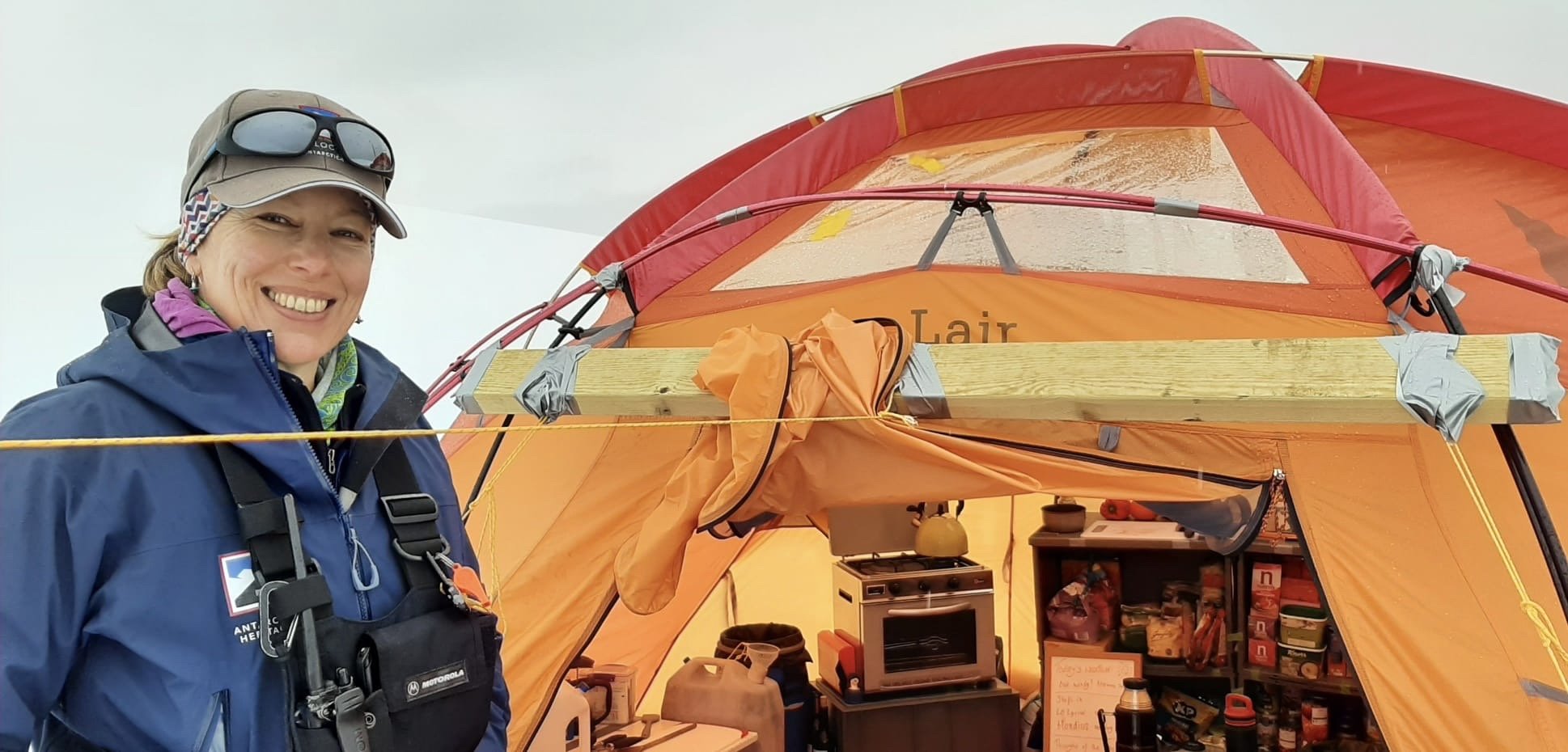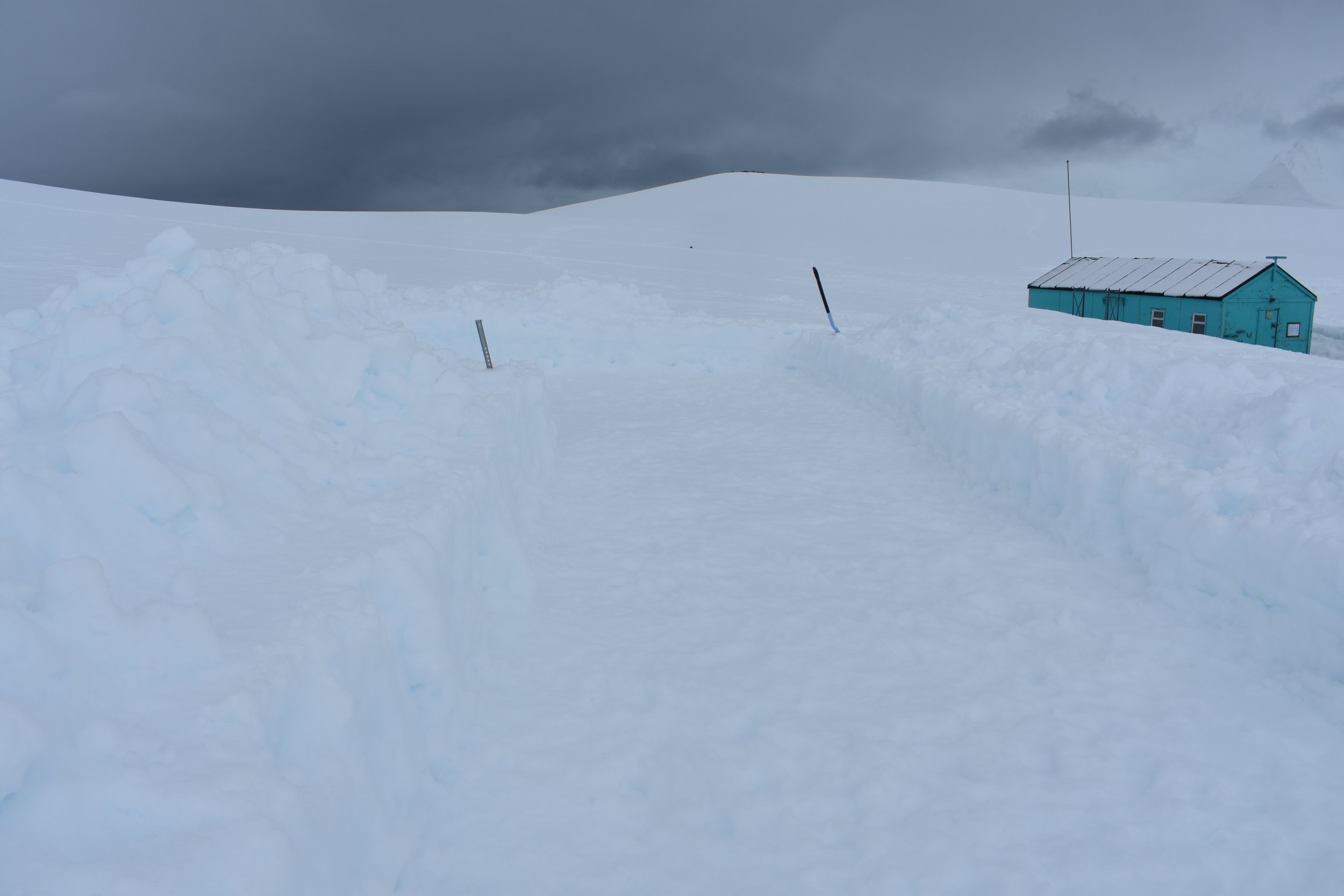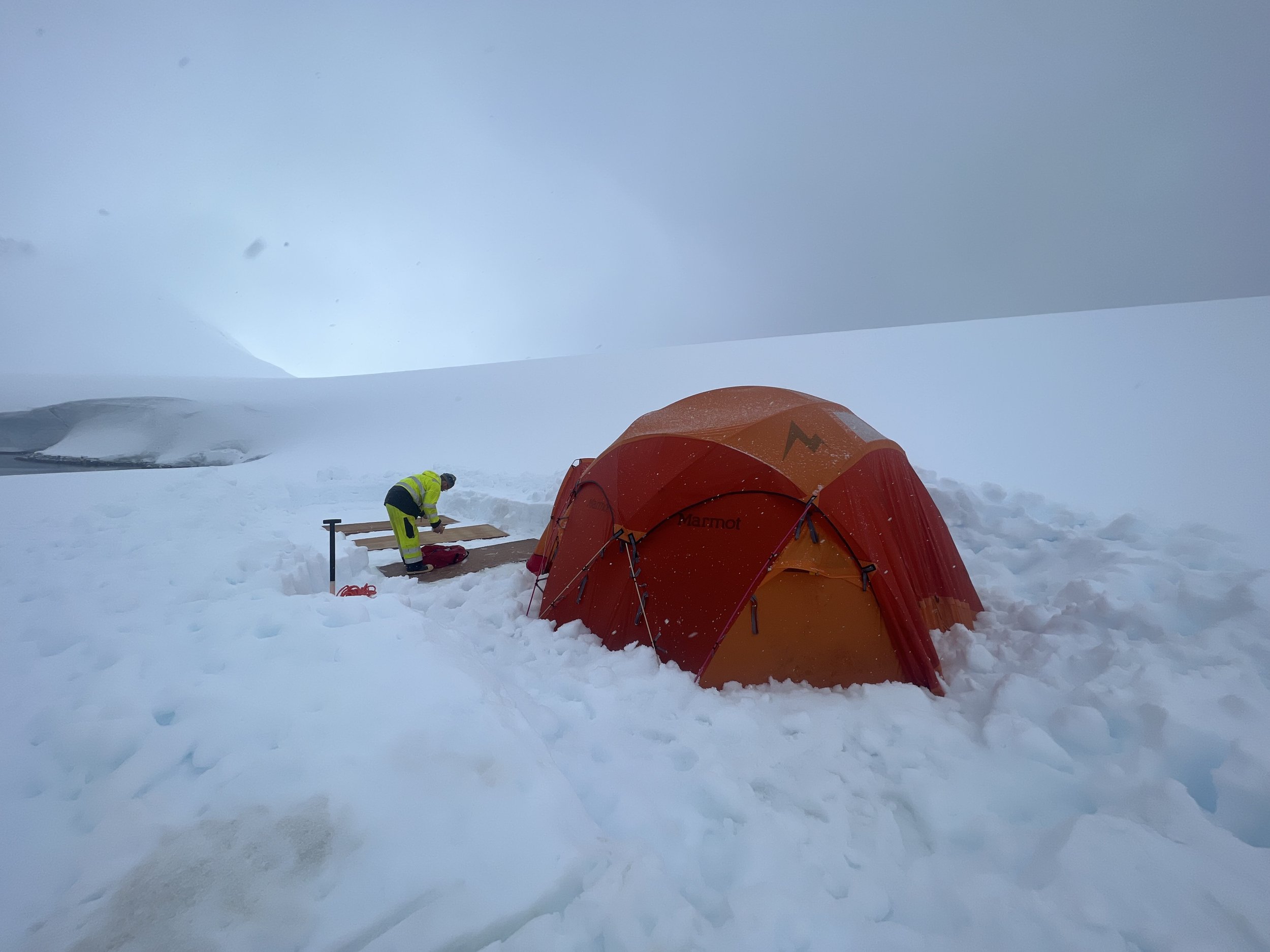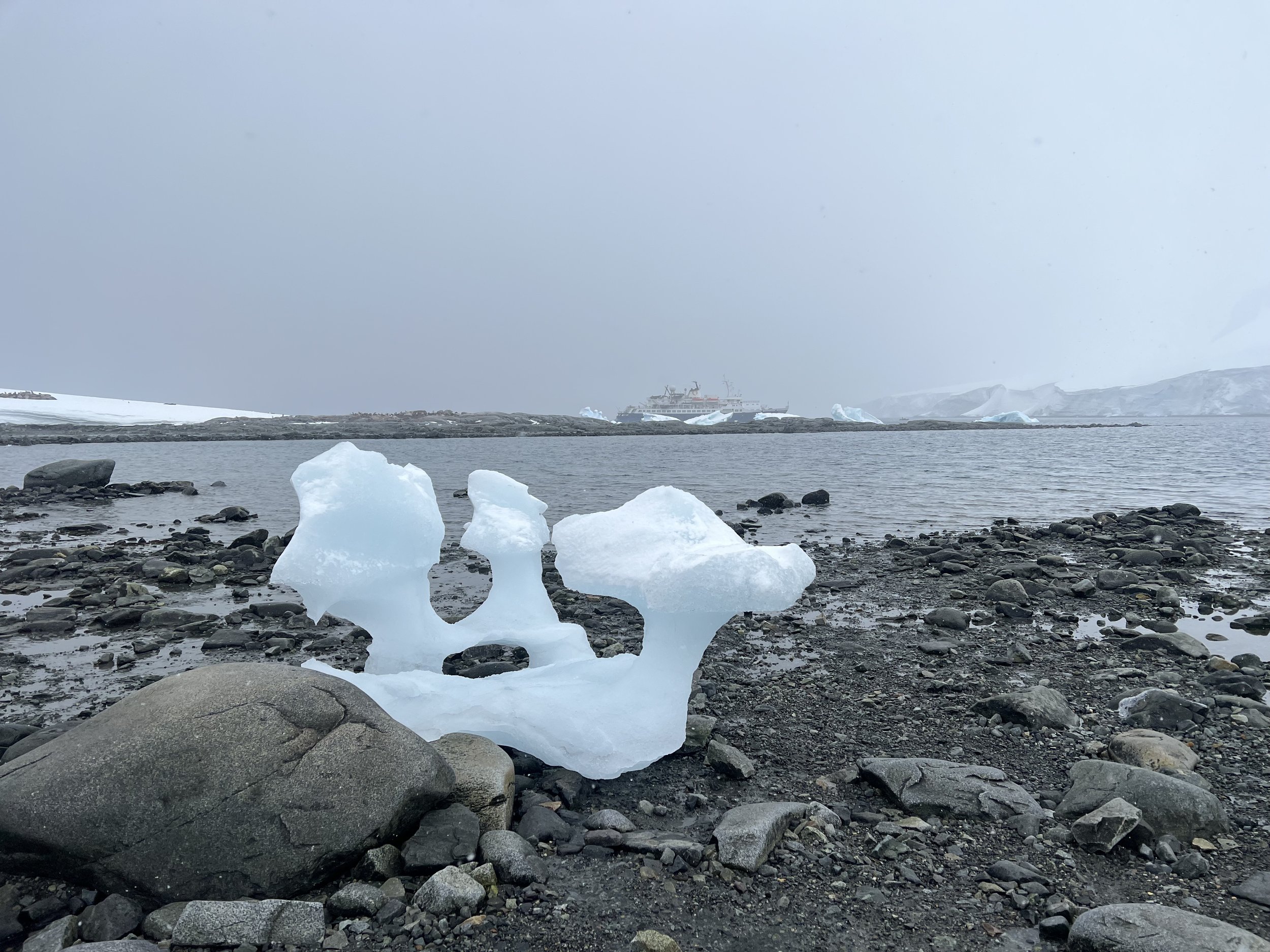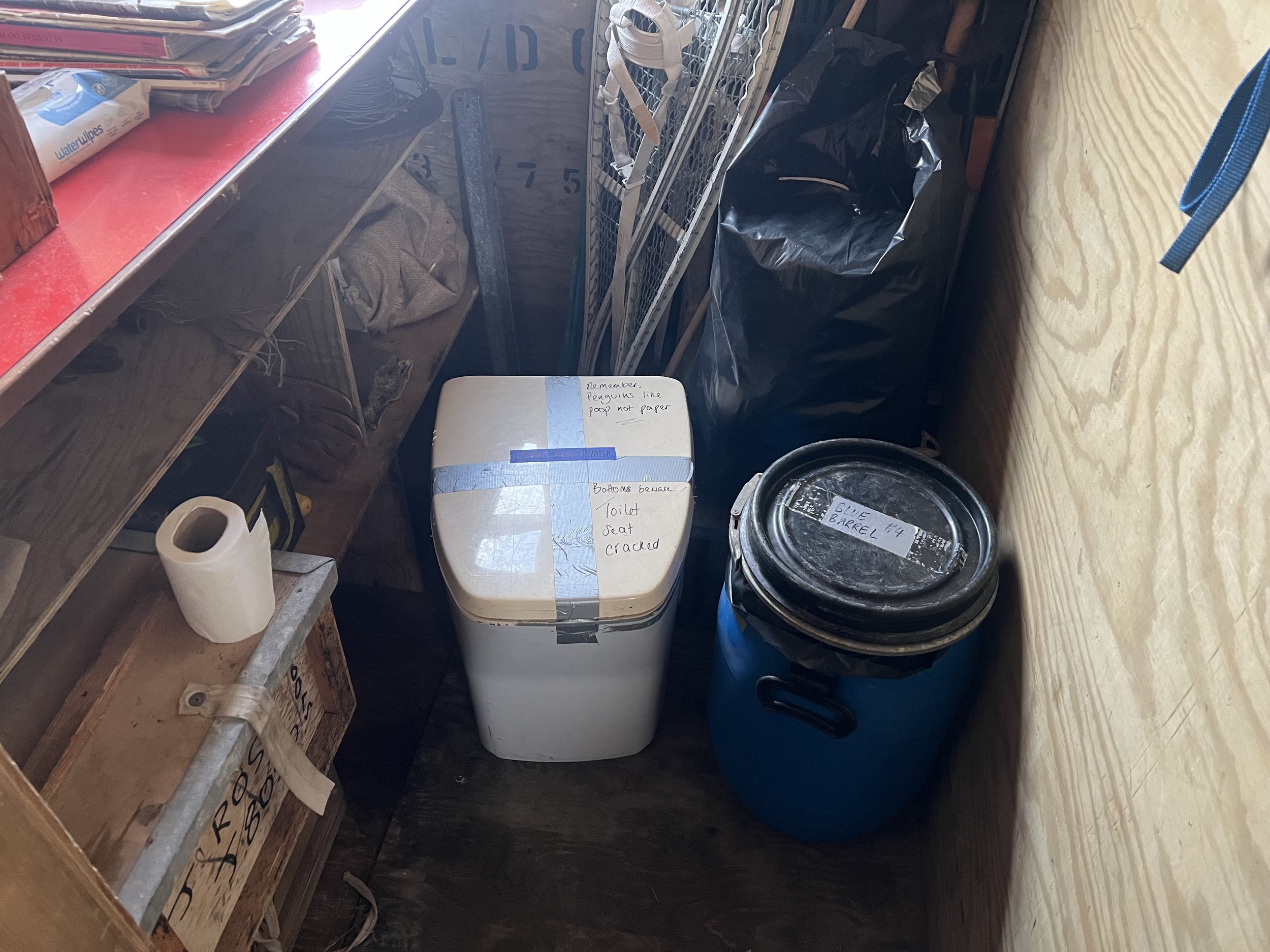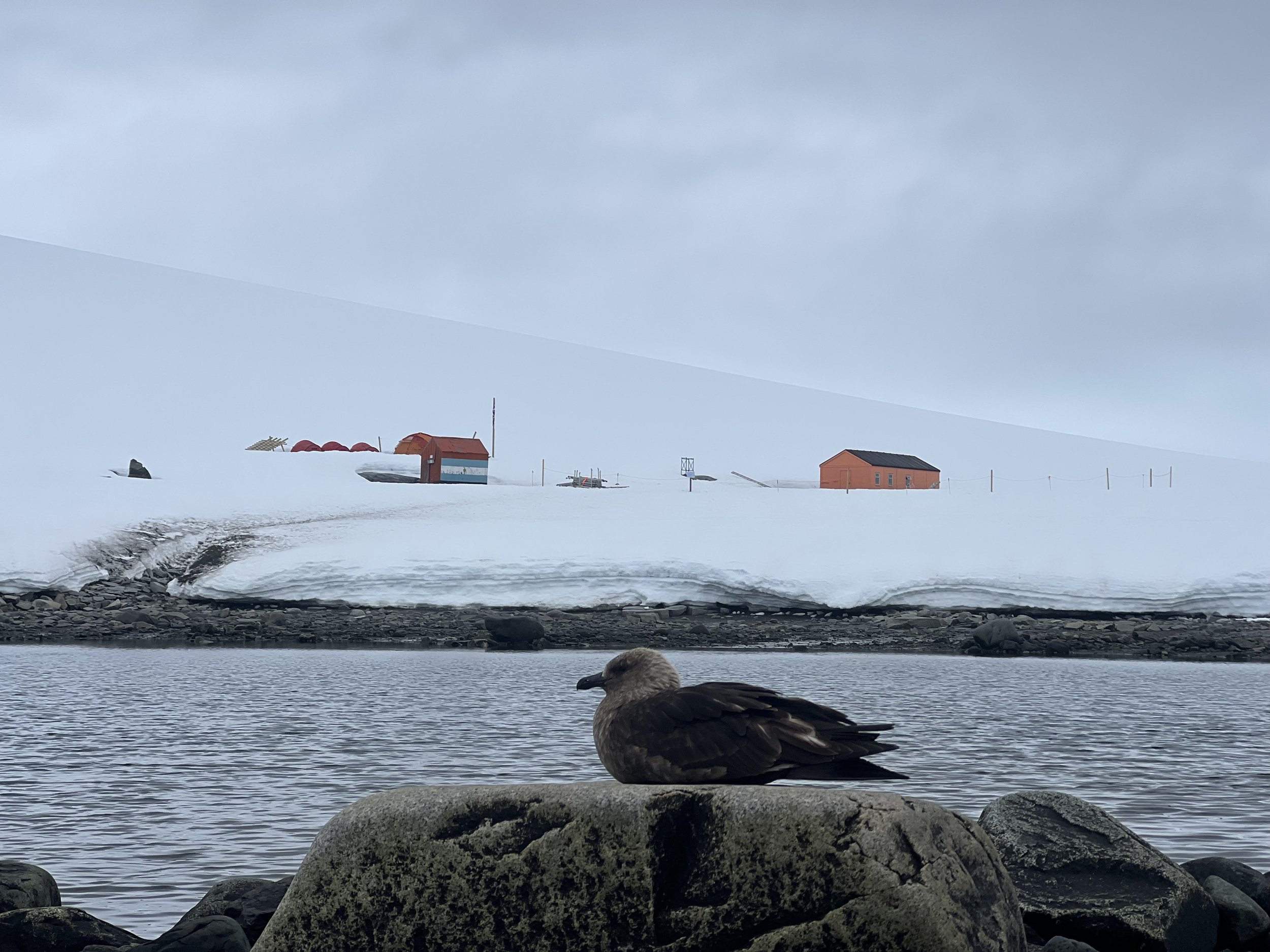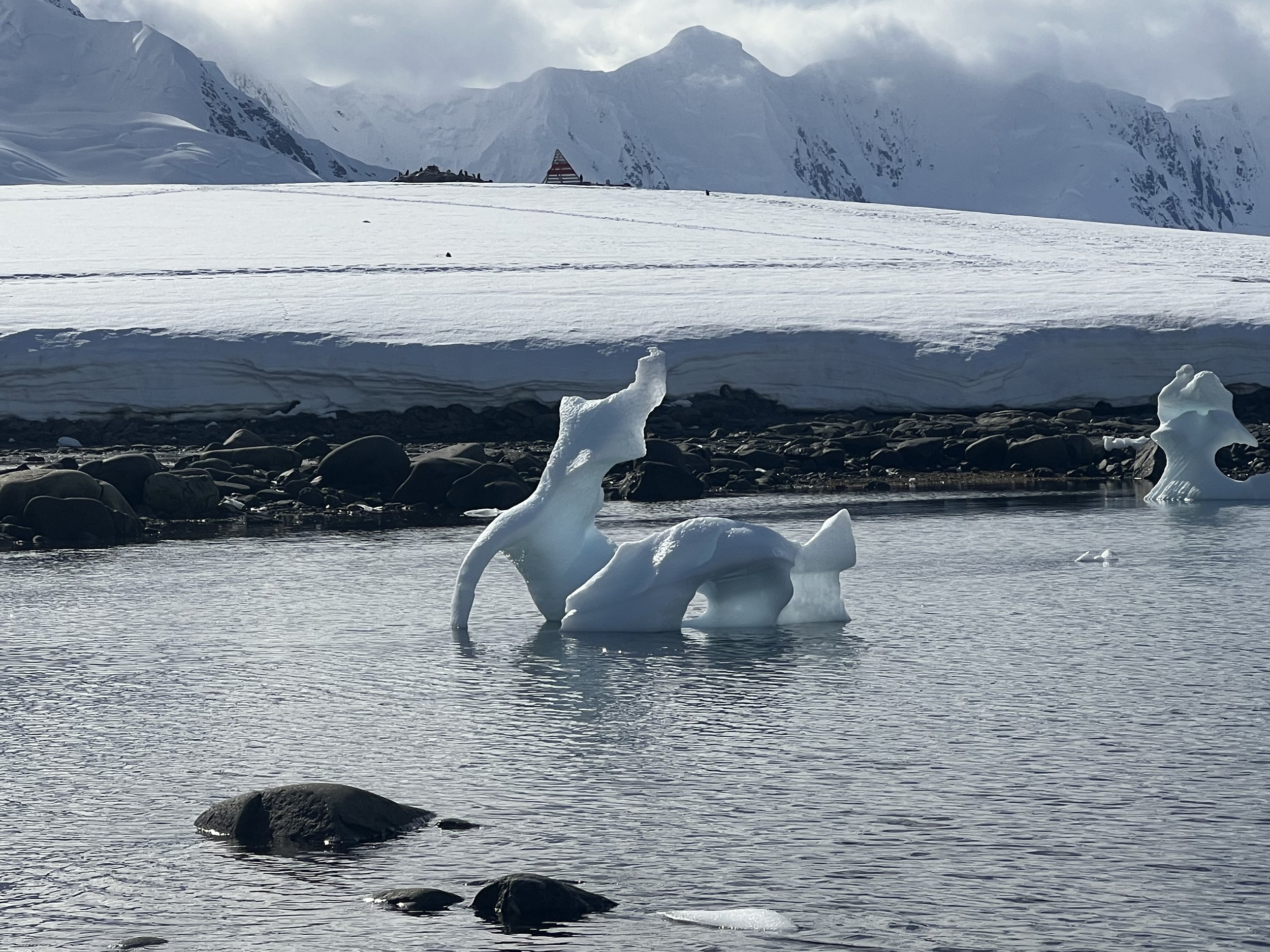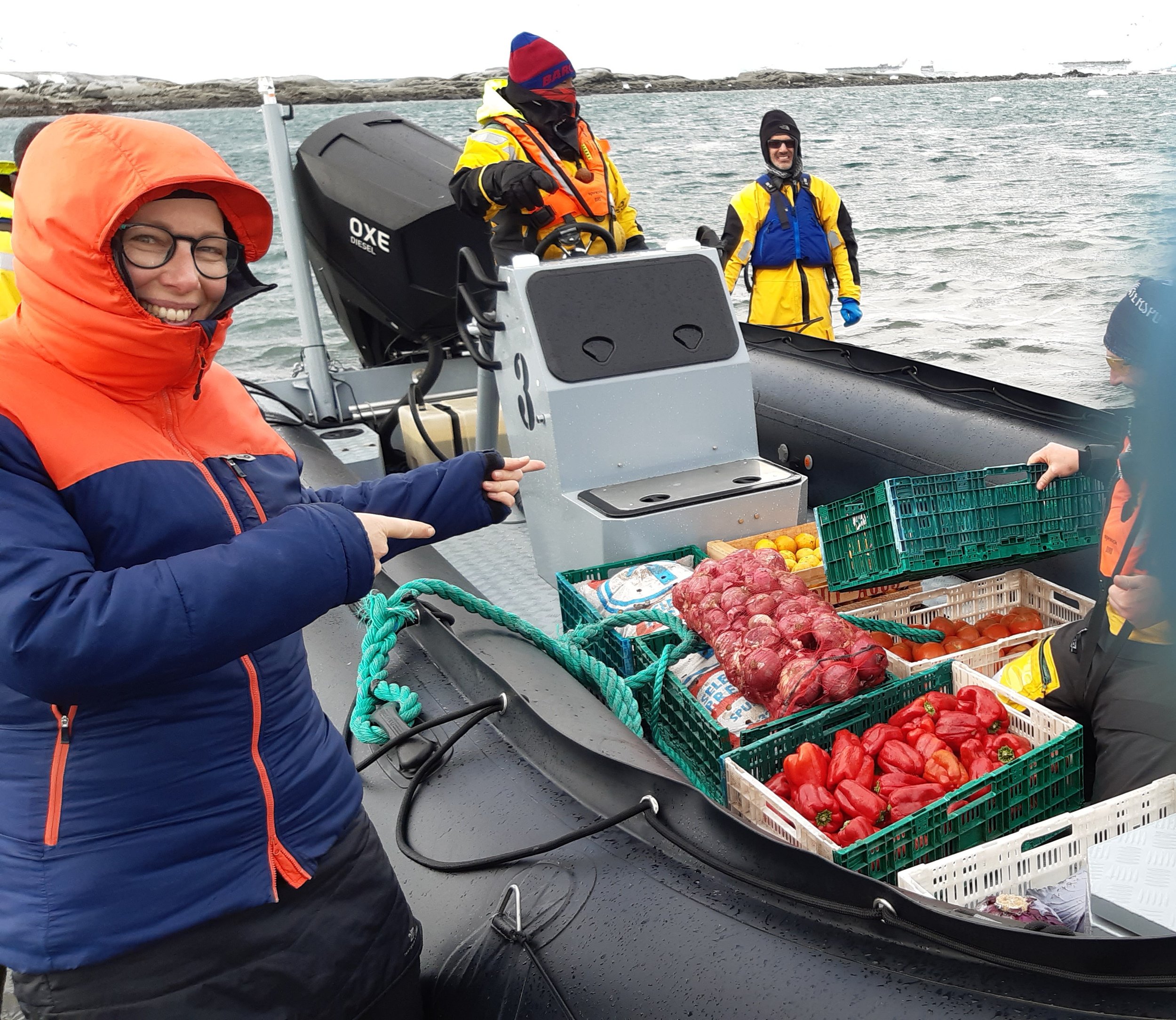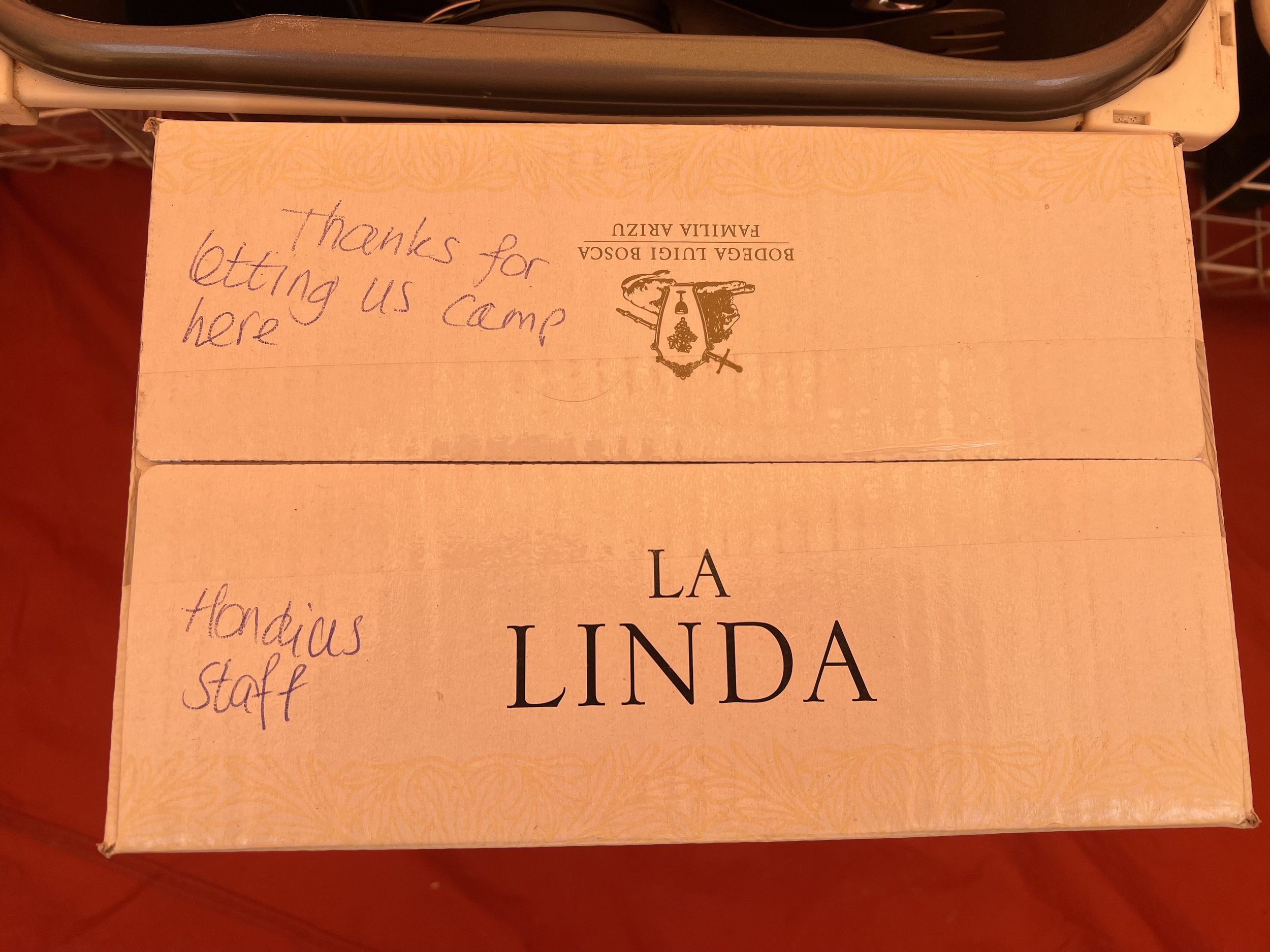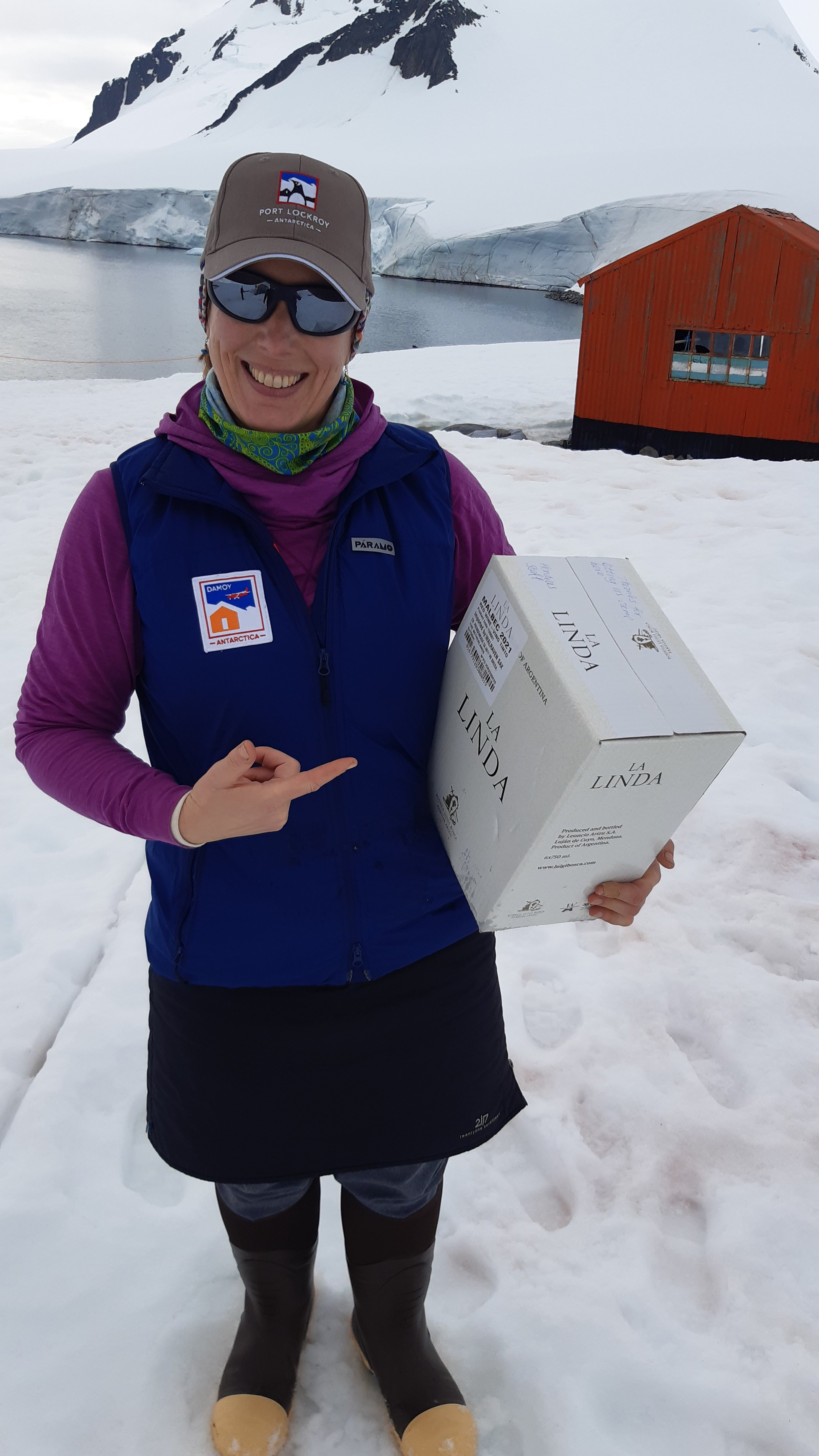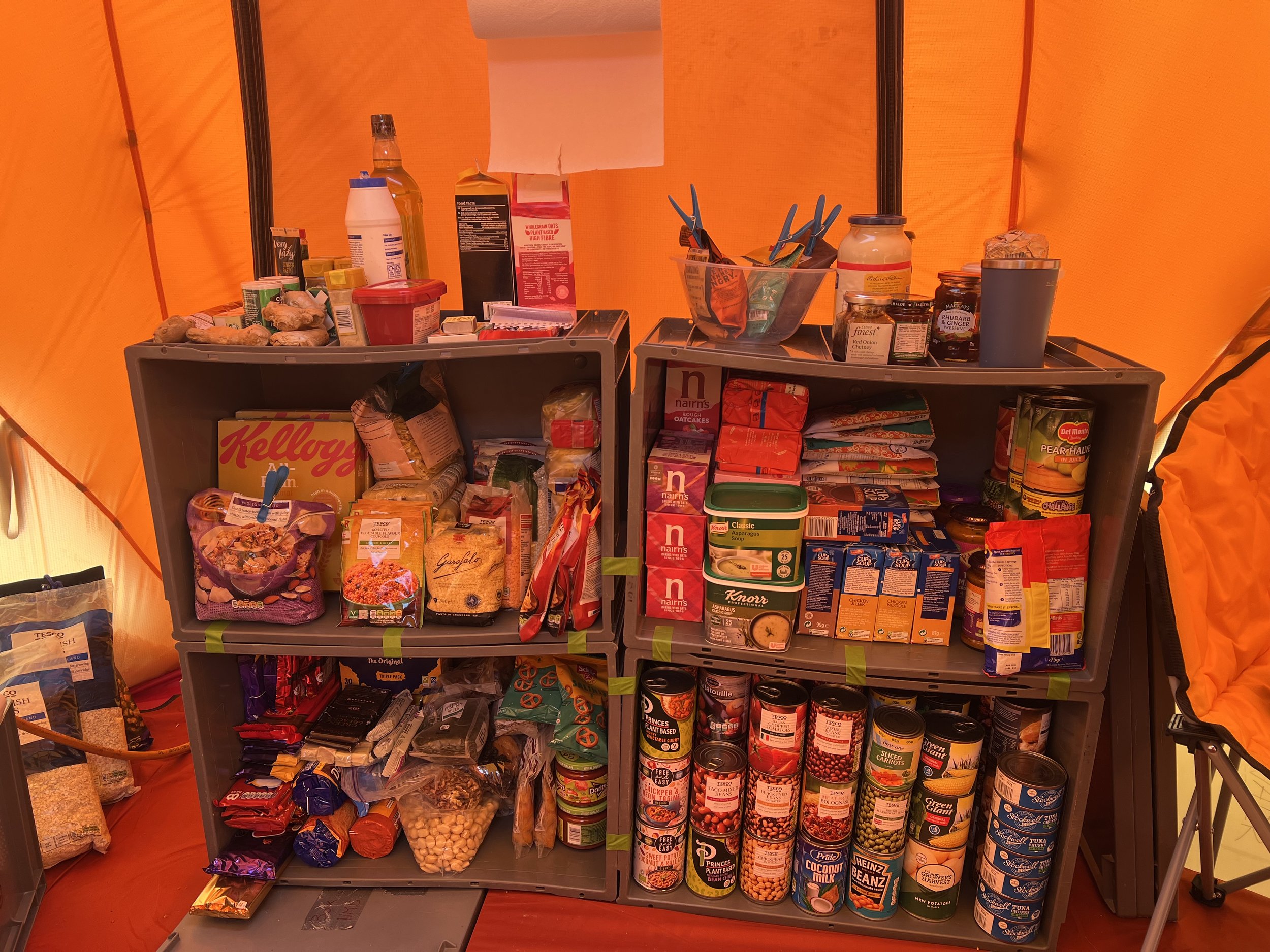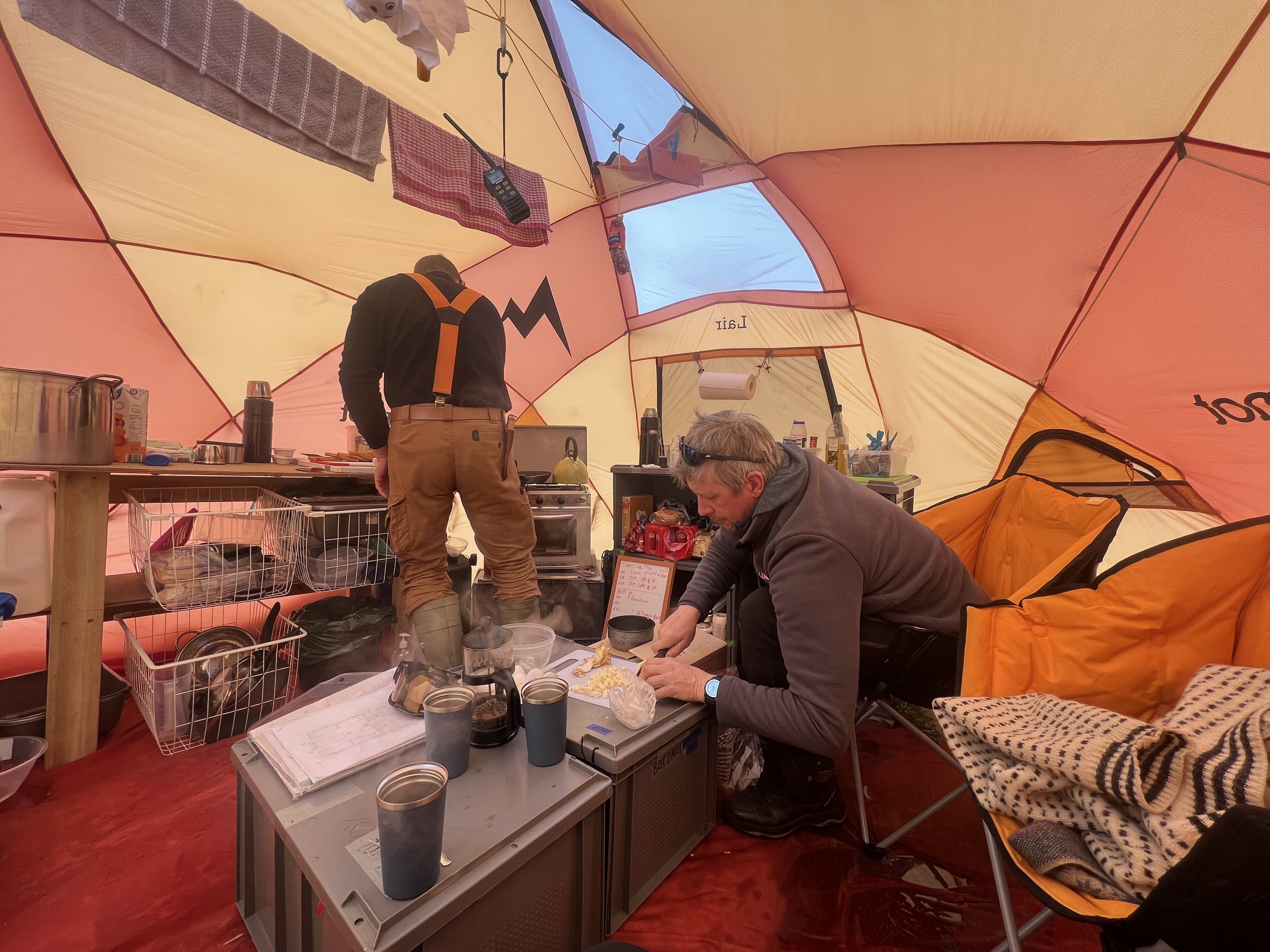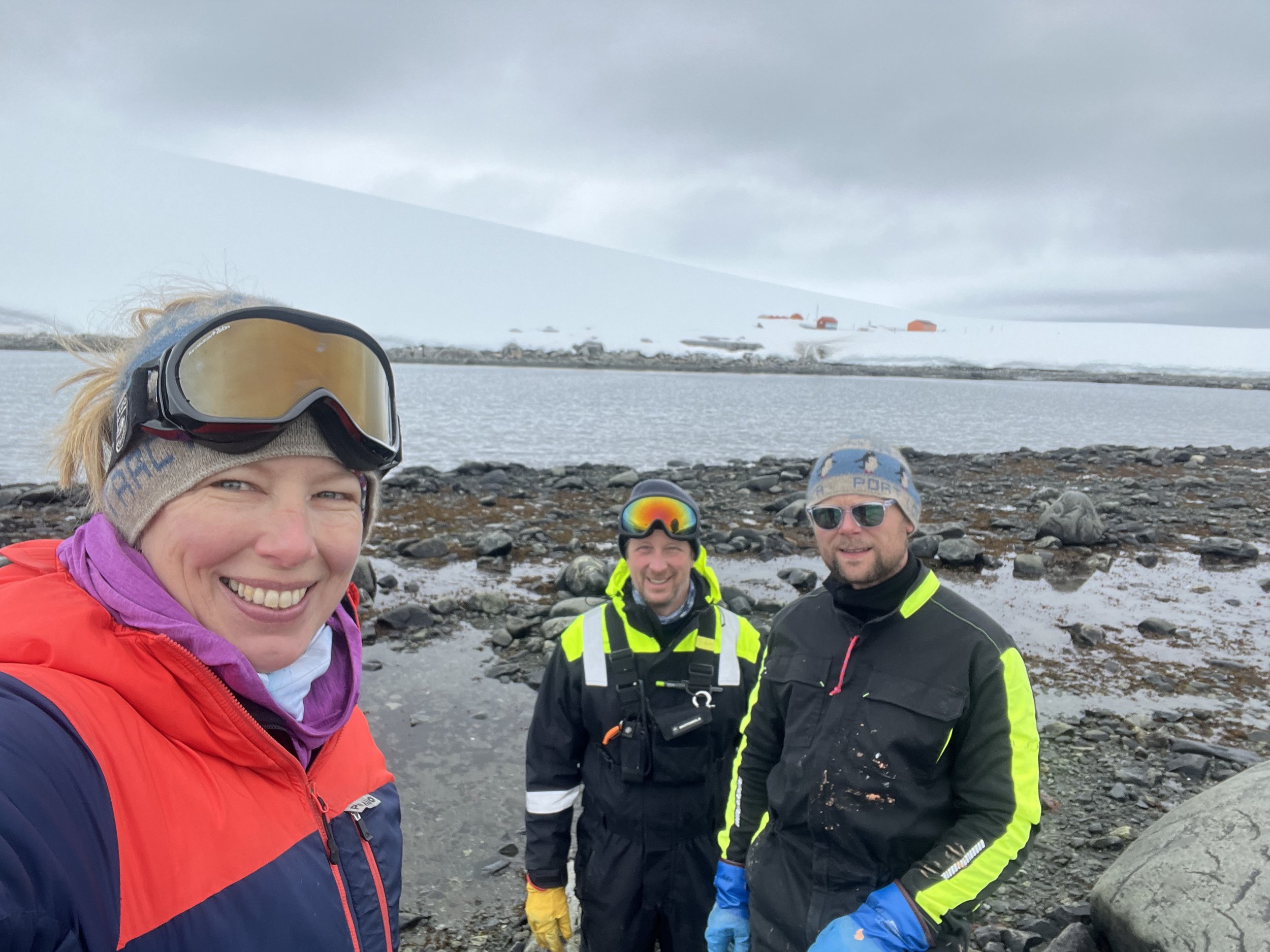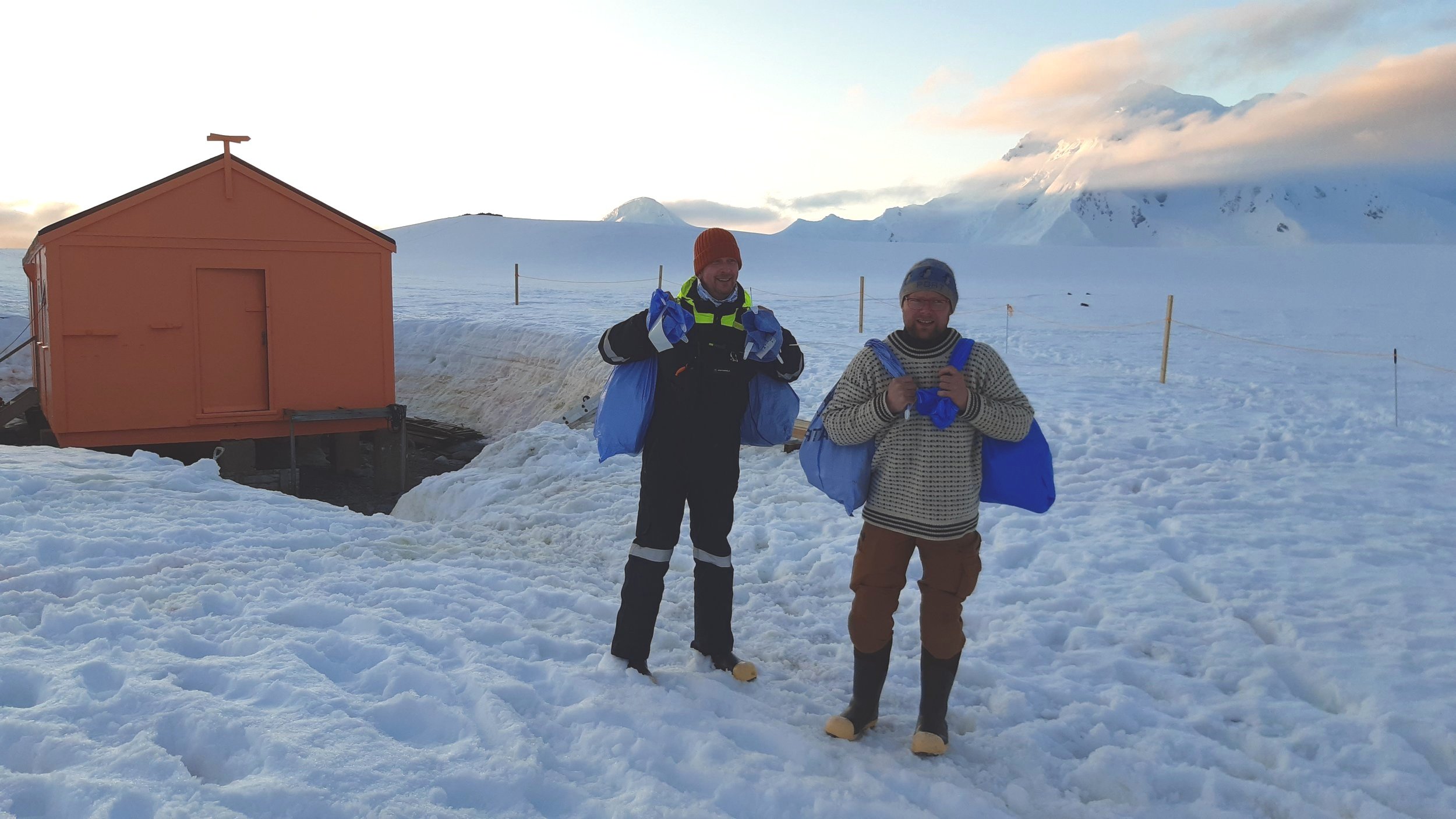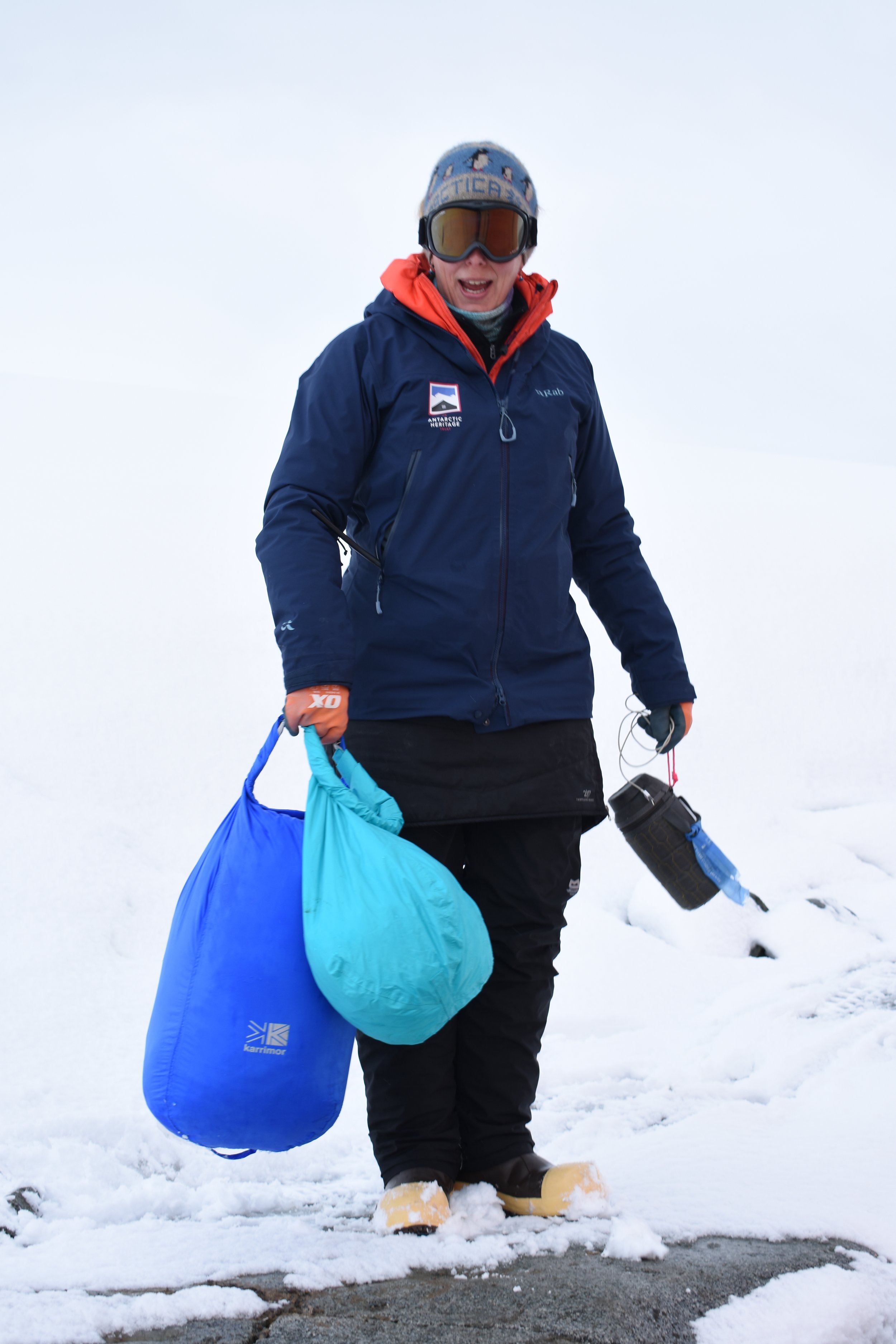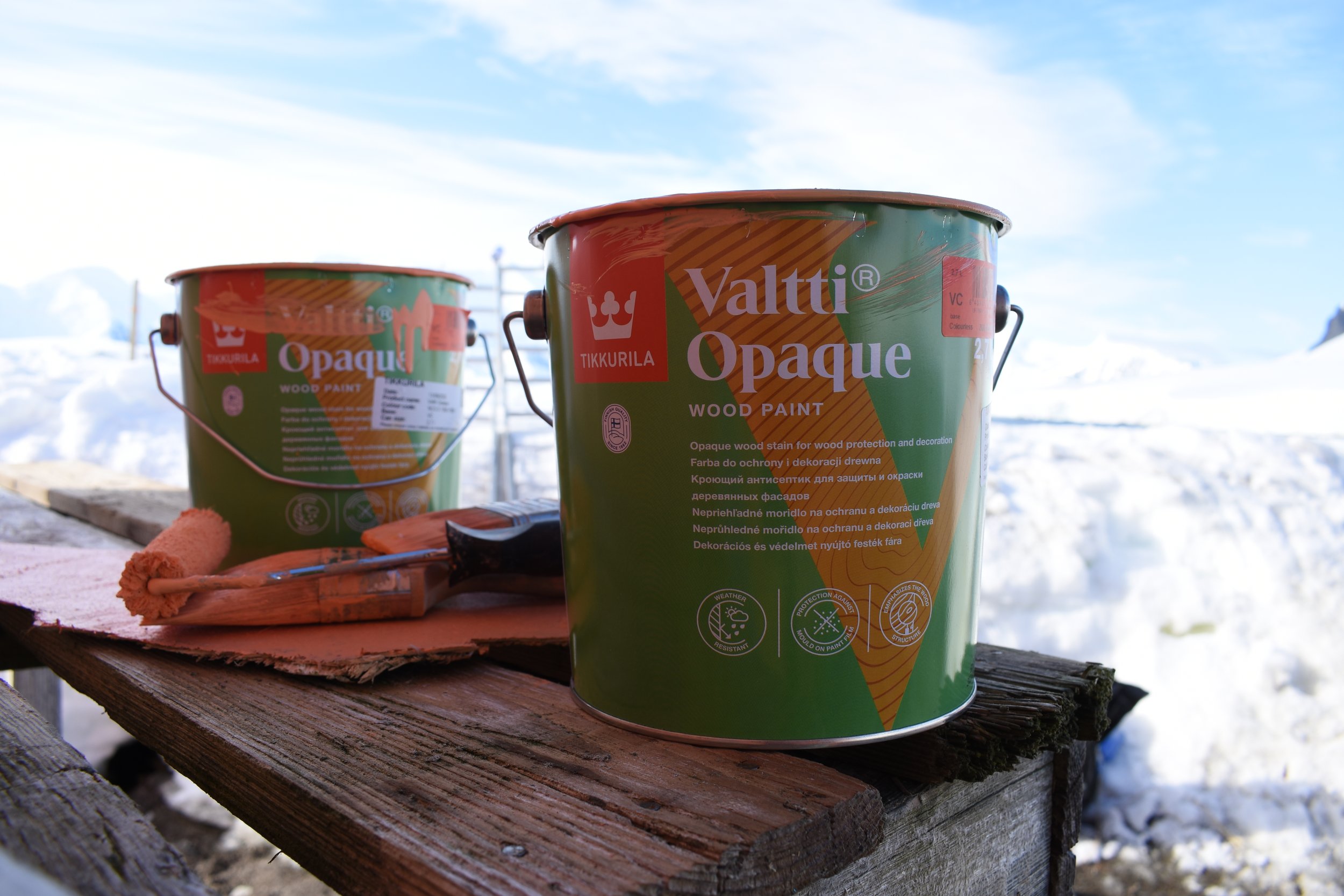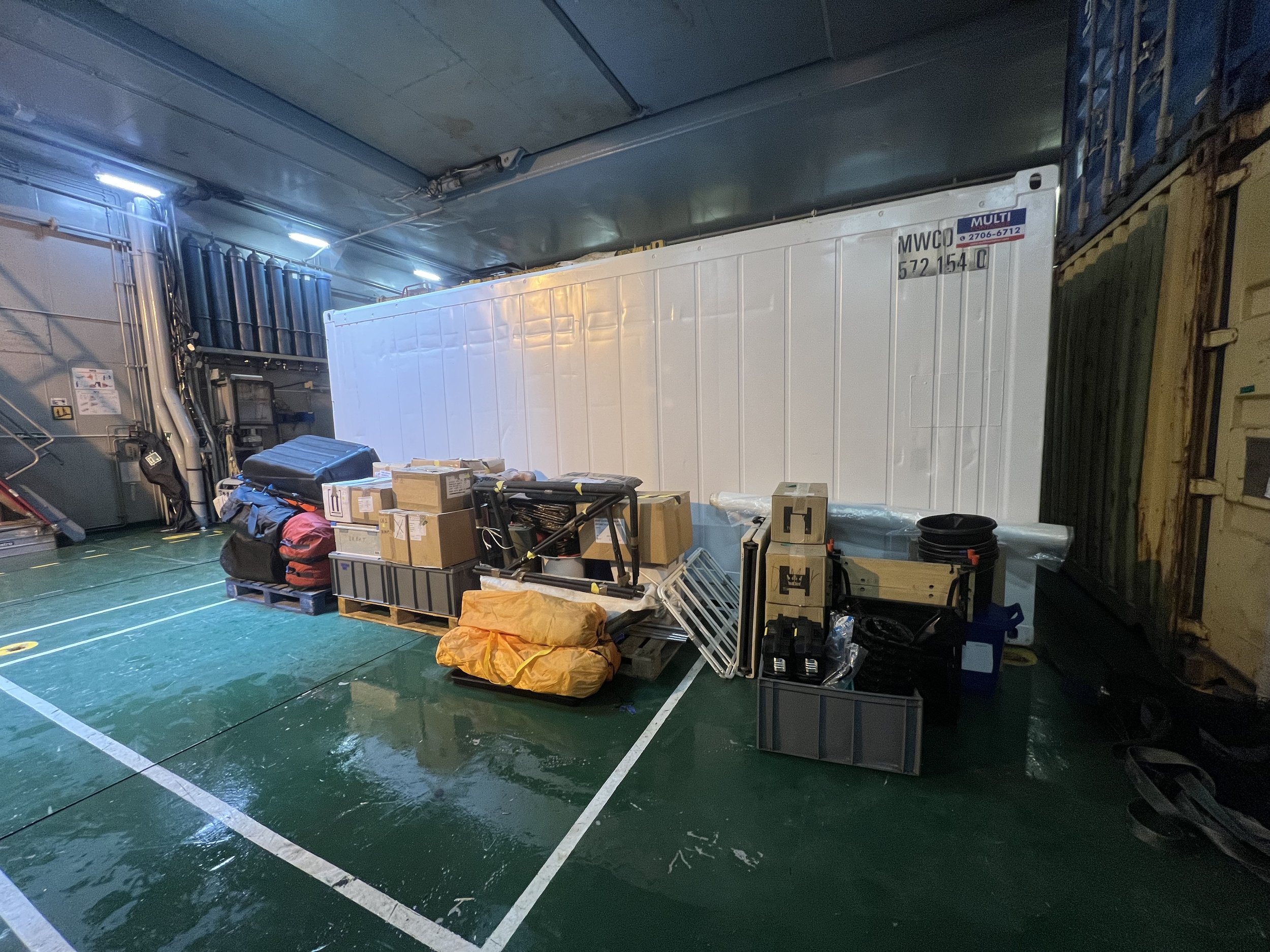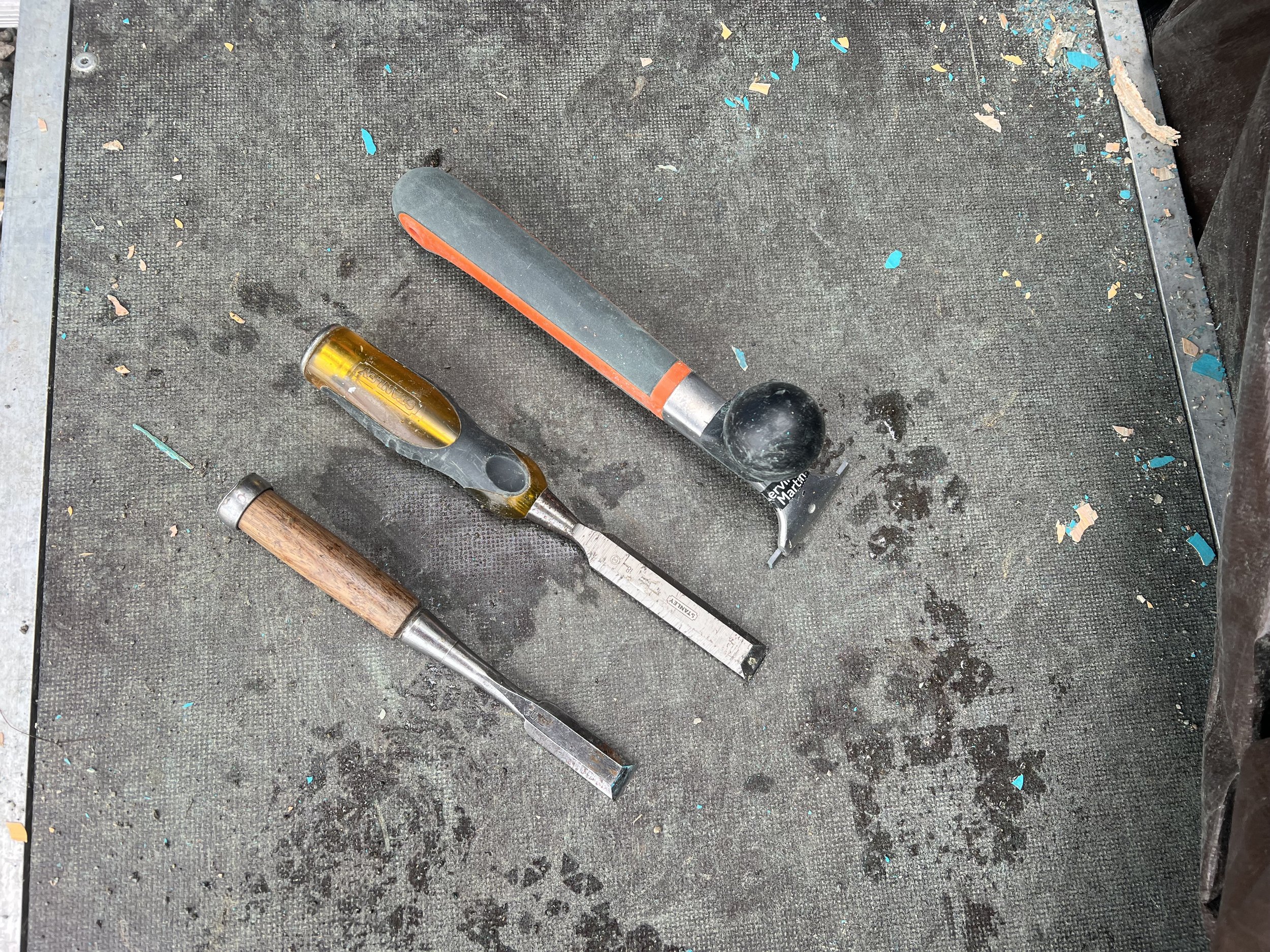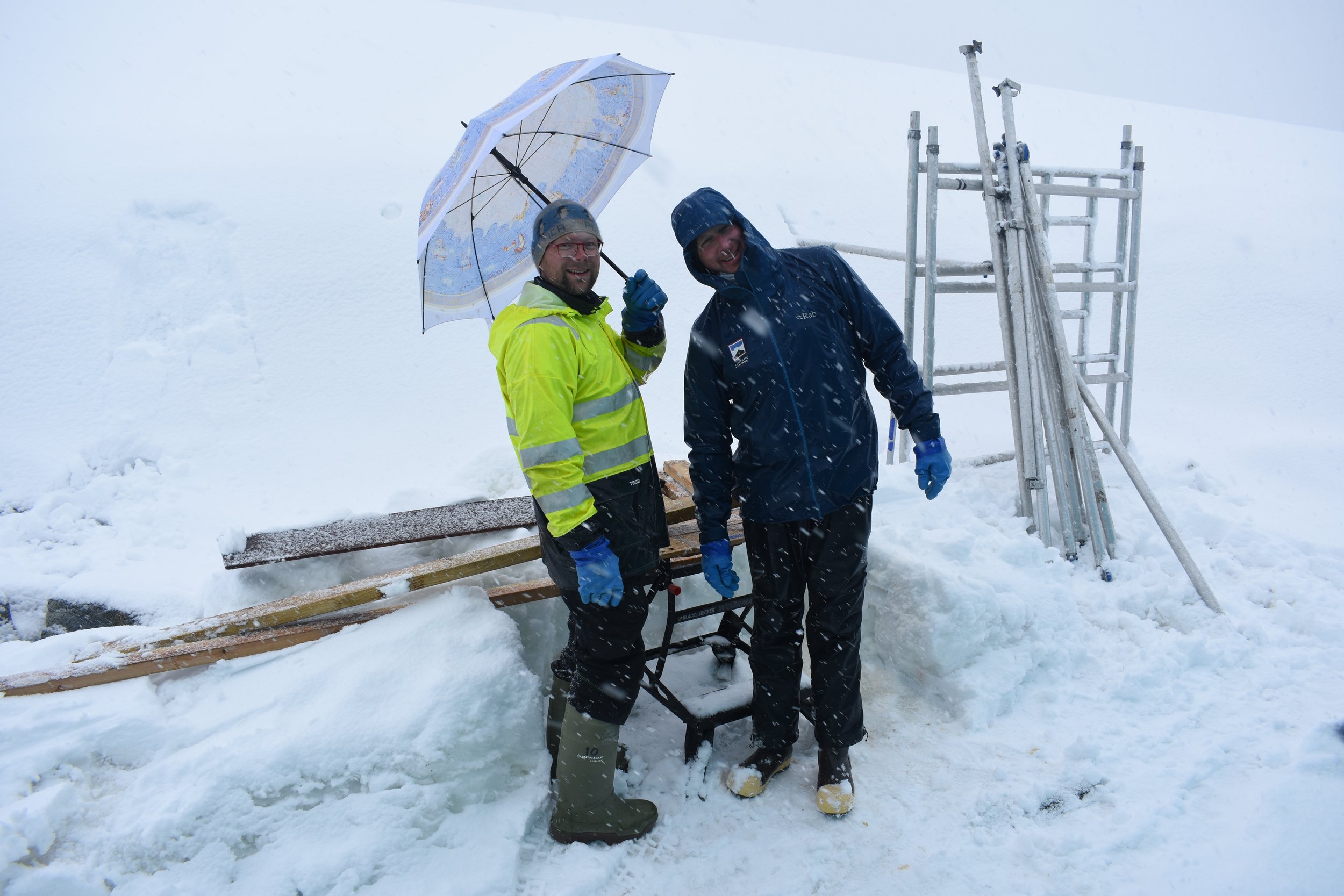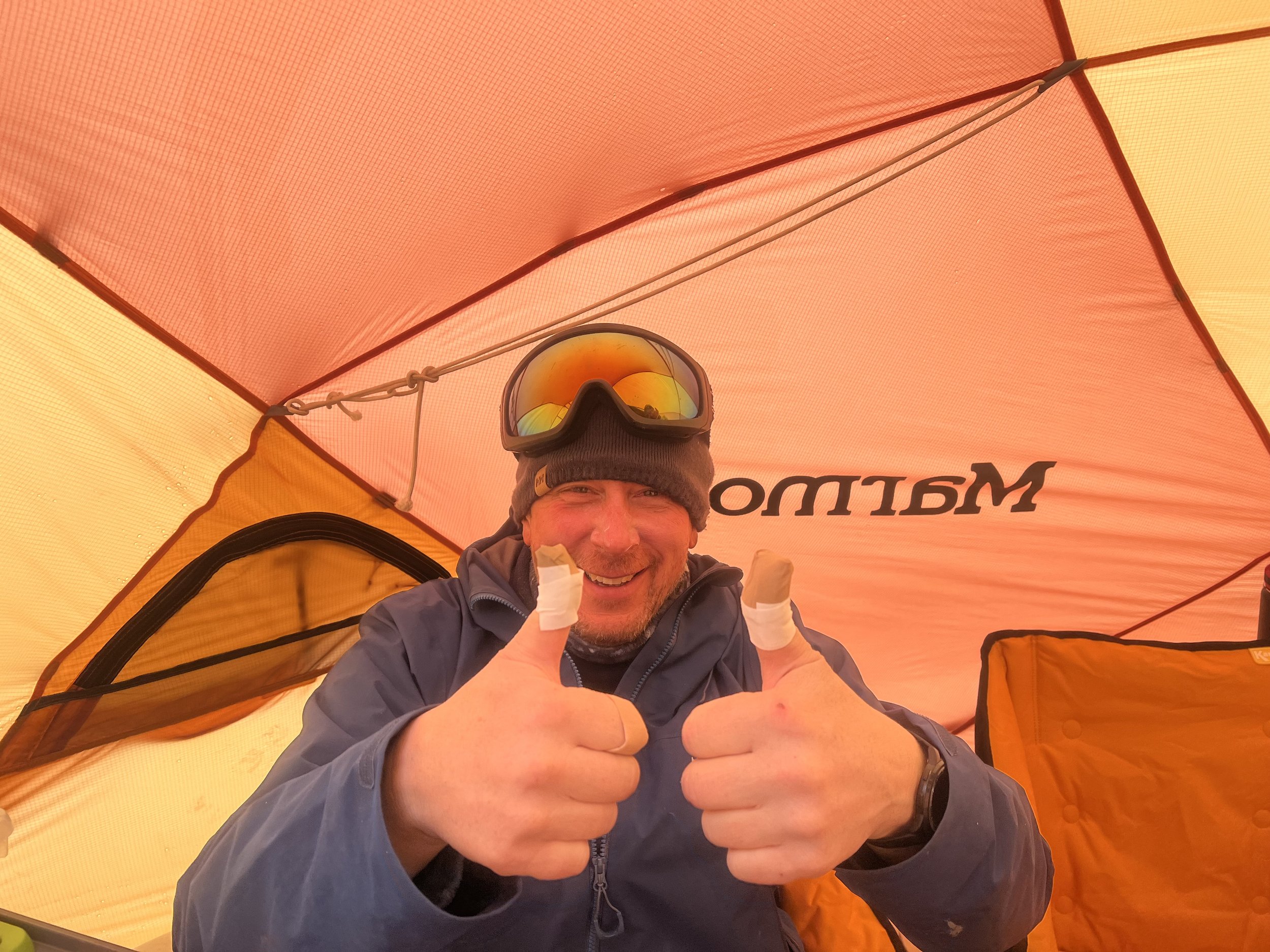The nitty gritty of 26 days working at Damoy Hut
In the third of my 4 blogs I will concentrate on what we wore, what we ate, what we used for work and where it all ended up. The nitty gritty of life working on the Antarctic Peninsula.
Setting up base camp – ply sheets, tent pegs and digging deep
When we were dropped off at Damoy on the first morning, we marked out a large area for our sleeping and mess tents and began to dig down to give us a bit of an advantage with the wind and also for when the snow started to melt, we didn’t want to be high up on snow islands.
The snow was very wet and heavy, very different to the dry snow I had experienced whilst climbing Vinson in the Antarctic interior a few years ago. This meant that you sank into the snow very easily and pitching a mess or sleeping tent on this very loose base would have meant we actually we would ended up in a soggy pit lower than the tent itself and could not have used anything inside. Martin saw a large number of ply sheets at Port Lockroy so we brought them over on the first wave of kit meaning we had a good solid base on which to pitch the sleeping tents and our mess tent.
Our sleeping tents were low profile and very strong so withstood the extreme winds we were regularly battered with, helped by being roped together, roped to snow stakes and roped to shovels buried at the back of our tents with the tent skirts buried in the snow. Ballast was everything. I was either digging the tents into the snow or digging them out of the snow, there was a lot of digging going on!
The mess tent was a Marmot Lair and as mentioned in my last blog we gave it a little help to stay upright. With a lot of TLC it lasted well and was nicknamed ‘home’. It was our kitchen, living room, dining room and office all in one 16sqm space.
Where we slept – sheep skins, single tents and being roped together
As we know sleep is very important, especially when you have 24 hours of daylight and your body is not sure when night starts or ends as it all looks the same. We had individual 3 person Terra Nova Hyperspace tents which, if you are my size of 5’6”, means you have loads of room. Sven is 6’4” and Martin a little over 6’ so fill the tent a little more successfully than me. Inside our tents we had a variety of matts to protect us from the cold and wet snow below and to give us a comfy night under canvas.
First up was a foam matt followed by a super thick Thermarest. On top of that was a sheep skin which added soft layer of warmth and then we had our Snugpak Softie Antarctica sleeping bags. I am used to sleeping in extremely cold temperatures in high and dry environments so usually use a down sleeping bag however in the moisture of the Antarctic peninsula down would have become soggy and useless pretty quickly so our sleeping bags were synthetic and worked well.
On the non-sleeping side of the tent we had another foam matt which our kit bags lived on which also acted as added insulation. I kept my kit in my Osprey Transporter kit bag to keep everything dry and in one place. We didn’t have much ‘stuff’ so keeping your tent tidy was an easy affair.
Sleeping bags heat up from the warmth of your body so you need to go to bed warm, strip off down to socks, pants, t-shirt and woolly hat so that your legs and body become the radiator which heats up the insulation of your sleeping bag and therefore you stay warm. It’s a tried and tested method which seems counter intuitive. If you usually go to sleep in a sleeping bag fully clothed and are then cold in your sleeping bag, try it!
With 24 hours daylight until the last few days of our stay at Damoy keeping the light out of your eyes was essential. You need to trick your brain into thinking it needs to sleep. On the first day of our stay at Damoy we were visited by 2 Hurtigruten ships. In the morning we had the pleasure of welcoming the MS Roald Amundsen and her passengers and expedition team. Yibo, the Expedition Leader, asked if we needed anything so I asked if they had any spare woolly hats in lost property. We had our fabulous Port Lockroy hats but with lots of rain and snow, everything became we and was hard to dry so having a spare to sleep in was important. He said ‘leave it with me’ and just before they left, he turned up with 3 brand new Helly Hansen crew hats which were gratefully received. This fleece lined dark grey beanie was long enough to go over my head and down to my nose so acted as my eye mask too.
‘Going for a walk’
Probably the most asked question during talks on ships, and in general, is what was our toilet like? Very basically, it was a bucket with a seat on top. Body stuff went into the bucket and paper went into a bin liner which was then double bagged before being disposed of along with our general and green waste on ships. We had 2 buckets so once one was third full we would swap it out for the empty one. Once that was a third full too we would ‘go for a walk’. We walked with the buckets down to the shoreline where the current was strong and there weren’t many penguins along with the grey water jerry can we could set the contents free.
Environmentally this is the safest option and we held a permit which allowed us to do this under the Antarctic Treaty. Oddly you would think that this would be our least favourite job however it gave us time and space to spend some time down at the shore, watching the penguins go about their own business, to safely wander past a Weddel seal or two sleeping on the spit, seeing if there are any whales in the bay, watching the different ice bergs floating by and spotting a wide variety of Antarctic birds flying overhead.
Safety is key – our emergency kit kept in the hut and how we communicated
We were living and working in an extreme environment with basic tools, scaffolding and a lot of wind. The chances of anything traumatic happening was actually quite slim however the consequences of an accident were on the epic end of the scale so safety was key. It was not only important to have an extensive medical kit but also emergency kit if we had to decamp, which on the 2nd night we did.
An unused med kit is the best one however having the right medical equipment in such an environment is essential. Once I had put together our 4 med kits I hoped we wouldn’t have to open any of them. 4 may sound excessive however they were split into a small ‘home’ general cuts/grazes/pills kit kept in our kitchen, another general cuts kit at ‘work’ which also housed the seal bite kit (not a med kit I thought I would ever have to put together and fortunately didn’t need to use) and our big red bag which housed the more serious kit for breaks, burns and bleeds.
Fortunately, the most serious injury had was split skin on Sven’s fingers due to the environment. Painful for him, good our emergency procedures. If we had had a medical emergency we had good back up through UKAHT, our medical emergency hotline via the Satellite phone plus calling ‘all ships’ on the VHF radio to see who was closest to us for support.
We also had an emergency box containing essentials to keep us going for a day or two if we had to abandon our tents. A couple of Jet Boils, dehydrated meals, bivvy bags and 3 more Snugpak sleeping bags, snacks including bars of chocolate and Nature Valley bars, tea bags (always an essential!) plus a few other items to keep us going whilst we waited for rescue. We would have decamped into the Argentine refuge which was built in 1953 as an emergency refuge for ships and yachts. It doesn’t contain anything but would have been a good space to hang out in for a day or two if needs be.
Communications between ourselves, Port Lockroy, ships and also with the office in the UK was very important so we had a good range of equipment which would allow us to do this. Each of us had a VHF radio which we could chat to our colleagues across the hill and over the water at Port Lockroy as well as being able to contact ships who were landing with us, or if we had an emergency. Channel 16 was the ‘make contact’ channel and we then moved to another channel to have a more in depth chat. We also had 2 satellite phones, one which we kept to hand and one which was kept in our emergency box. We were allocated 10 minutes of personal calls per week but also had a specific email address which we could connect to via the BGAN satellite system. Think of a wifi route on steroids. This enabled us to be in touch daily with the office to update the team of our work and to obtain weather forecasts and ship schedules as well as keeping in touch with our loved ones at home. We had no access to social media or anything else you can normally see on the internet as it was an email only connection which was a joy. Pure social media detox for 6 weeks was just what was needed.
What we ate – cooking for 3 for 26 days in Antarctica
When I arrived at Port Lockroy I had a list of tinned and dried food to put together and wondered what 26 days of eating out of tins would be like as I boxed up tagine, veggie bolognaise and baked beans. I’m happy to say, it was better than I had hoped! We were well served for cooking essentials such as onions, garlic and ginger by ships plus fresh veggies when they had spare. We were also given a stock of eggs and cheese by our colleagues at Port Lockroy when we left their shores and they also kept us stocked with a variety of other goodies as they became available to them from visiting ships which did not stop with us.
There was almost a competition between ships with who could give us the best goodies and there was a wide variety on offer. From oranges (vitamin C is very important), to fresh veggies which were at a premium, to soya sauce and the most delicious black sugar however the best gift was a box of La Linda Malbec which had been very kindly left by cruise ship Hondius after their some of their passengers and expedition team camped at Damoy during our first week. We had said hello to their lovely expedition team late in the evening when they came ashore to set up but we were not awake when they left to say goodbye. We went down to the generator to turn it on that morning and found a white box of fabulousness and a lovely note written on it. I’m yet to buy another bottle of La Linda but when I do it will take me right back to Damoy.
I tried to mix things up each day depending on our fresh stores and also the variety of tins I put together which usually saw us eating around the world. We were all veggie during our time down south and had curry nights, Mexican nights, a Moroccan night was a little on the brown side and when Martin said ‘how do I eat this’ with ‘this’ meaning tagine and couscous I knew it wasn’t a night to be repeated. Fajitas came onto the menu when we were given potato wraps and peppers by a ship as did burgers and then fish finger and chip butties when another ship give us these goodies which I split out into 2 meals. Martin’s first chip butty was a moment in time.
The guys cooked breakfast which was either porridge or some style of eggs with plenty of proper coffee, elevenses was more coffee and biscuits or chocolate, lunches were a mixture of cheese and crackers or tuna and something. We ate a lot of tuna! More tea and biscuits late afternoon were consumed before I made dinner.
I have never had to cook for many people for a long period of time and despite my trepidation, and probably that of Sven and Martin, we all survived without incident and I put out some great cuisine given what I had to work with. Thanks Sven and Martin for eating it all!
What kept us warm and dry – the kit and the clobber
I have a good set of tried and tested kit, the majority of which is Paramo Directional Clothing who I gear test for so in my pit stop at home before I dashed back to Antarctica I put together a good set of kit for the deep south. I was also given a UKAHT branded fleece, t-shirts and hoody plus a Rab waterproof and a pair of Mountain Equipment waterproof trousers. I had so much conservation kit to take out I didn’t have much room for much so left out my fabulous Paramo salopettes which have seen me through many a mountain adventure. I was asked by Ellen Piercy on social media which piece of kit I hadn’t taken but wish I had and it was these warm wonders along with my Sealskinz socks.
When I was at Port Lockroy I heard that Camilla Johns, Head of Development at UKAHT was on her way down to spend 2 weeks with the Port Lockroy team so I pinged her a desperate ‘do you have space for my salopettes’ email. When she replied with a yes I sent a desperate ‘Mum, can you whizz around to mine, find my salopettes and Sealskinz socks and post them to Camilla’ Fortunately my wonderful Mum managed to find my kit and post it off, it arrived in time and 10 days later my parcel of joy arrived a few days after we had set up camp at Damoy.
Martin and Sven had their own favourites which included special overalls which Martin always uses in Norway. He also came in a jumper which was an exact match to one which was a museum piece at Damoy Hut. It just goes to show that what we see as old-fashioned kit still works well today.
I also brought my much loved and used Primaloft skirt which was an essential purchase in Sweden last year before I took part in a long-distance Arctic race. It has also now been around the world on treks to cold climbs to keep my bubble butt nice and warm! It’s a well-known fact that women lose a lot of heat through their bums and thighs so why not give them a little extra insulation.
To be specific here is what I wore: underwear was SueMe Beech shorties, Patagonia Switchback bra, Smartwool mountaineering socks and Sealskinz waterproof socks; thermals were Marks and Spencer HeatGen thermal tops and bottoms; mid layer was Paramo Gridtech hoodie or UKAHT fleece and Paramo Torres Medio gilet; outer layers were Paramo Enduro salopettes and Paramo Torres Alturo jacket followed by my UKAHT Rab waterproof if needed. Steel toe cap boots were provided by XtraTuf. I had 2 sets of under layers but that was it for 26 days plus the days either side at Port Lockroy, no need to choose in the morning, a very easy wardrobe!
Our work equipment – working with basic tools in an extreme environment.
In order to do our jobs safely we needed good kit. Much of the equipment was already at Port Lockroy including the scaffolding and ladders and the rest was shipped down from the Falkland Islands on HMS Protector. The scaffolding was different to the type you see on buildings here. It came in sections, clipped together with specific poles and we had pre-formed boards with hooks on rather than the traditional scaffolding boards.
Another much asked question when I did talks on cruise ships was which tools did we work with. When I said that we used human muscle powered scrapers the reply was ‘why didn’t we use heat guns or electric sanders’.
We had 2 small generators which kept our environmental footprint low, one to use and one as a spare. The generator charged our radios, sat phones, laptop, BGAN satellite comms unit, power drill, hand vacuum cleaner and our mobiles. A heat gun would have required a larger generator plus, with all the wind and very low temperatures, wouldn’t have actually made any difference to the ease of scraping the paint off the hut. Power sanders again would have required a larger power source and would have created a huge amount of dust into the atmosphere, even if they had an internal collection system. We had the tools and we were the power!
The paint was donated to the project by its manufacturer Tikkurila. A Finnish company who made this paint specifically to match the colour needed and to also deal with the extreme environment we were working in. It worked really well and I hope you’ll agree that the hut looked very smart when the job was completed.
Vital support from cruise ships
We knew which ships were likely to land passengers at Damoy by the means of a ship scheduler. This list was sent to us by the office 3 times a week via email and contained a spreadsheet of who was going where and at what time. The cruise ships fill this in online on a central platform so that they also know who is going where and when. Very helpful for us to know when we could fill water, offload waste and when a potential shower was on its way.
In order to stay healthy we also needed to drink plenty of water. Melting and snow is not an efficient method environmentally or time wise, ice was too risky to get where we were and again not environmentally wise or time efficient in our situation so our jerry cans were filled up by cruise ships when they landed passengers with us. They have desalination plants on board and we were drinking good old Antarctic water which had been sterilised, fortunately minus the krill and saline.
We were very careful about the waste we created from the toilet variety mentioned above, to packaging, hut waste and food. It all had to be split out into different sacks which were double bagged before a variety of ships kindly took it off our hands. Once we had cooked and eaten, we scraped our plates and pans into a food sack so that we were not putting food waste into our grey water which went into the sea. This sack was marked accordingly, as were our other waste bags from general to tins, bottles and cardboard. These were split out when they arrived on the ships into their various digesters and waste bins and logged by us to keep tabs on who had taken delivery of what and when.
Ships also helped us with clothes washing and showers which were both gratefully received. We collected our grubby kit, bagged it up and when one of us went on board for a shower, which was maybe a couple of times a week, our washing would come back smelling all lovely and clean. Opening our dry bags to fresh clothes was always a highlight of the week as was getting clean in a cabin shower.
Once again I could have written a whole blog about each part of our kit and equipment but I hope I have answered any questions you may have had about how we lived and worked at Damoy. If I have missed anything you would like to know about, please do let me know!
And finally…
In my final blog out next Tuesday I will recount tales of the many wonderful people we met from skippers to expedition teams to those who were part of the history of Damoy Hut.
A big thumbs up from Sven
Photo credits to myself, Martin Herrmann and the Port Lockroy team
